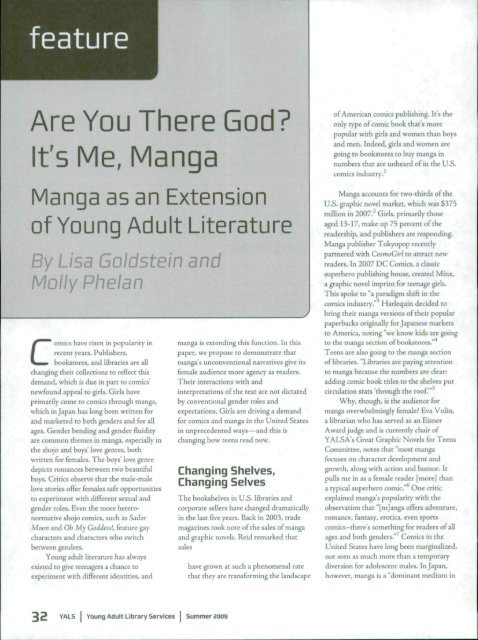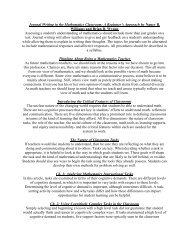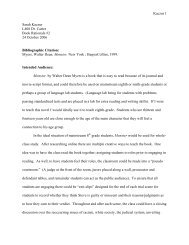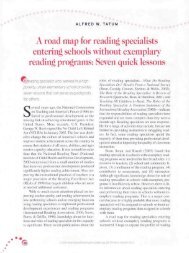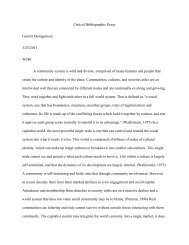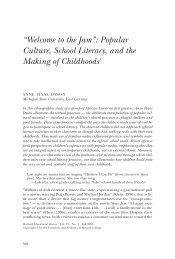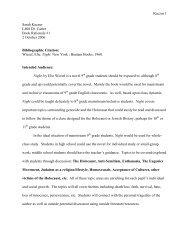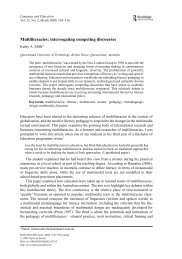feature Are You There God? It's Me, Manga - Oncourse
feature Are You There God? It's Me, Manga - Oncourse
feature Are You There God? It's Me, Manga - Oncourse
Create successful ePaper yourself
Turn your PDF publications into a flip-book with our unique Google optimized e-Paper software.
<strong>feature</strong><strong>Are</strong> <strong>You</strong> <strong>There</strong> <strong>God</strong>?<strong>It's</strong> <strong>Me</strong>, <strong>Manga</strong><strong>Manga</strong> as an Extensionof <strong>You</strong>ng Adult LiteratureBy Lisa Goldstein andMolly PhelanComics have risen in popularity inrecent years. Publishers,bookstores, and libraries are allchanging their collections to reflect thisdemand, which is due in part to comics'newfound appeal to girls. Girls haveprimarily come to comics through manga,which in Japan has long been written forand marketed to both genders and for allages. Gender bending and gender fluidityare common themes in manga, especially inthe shojo and boys' love genres, bothwritten for females. The boys' love genredepicts romances between two beautifulboys. Critics observe that the male-malelove stories offer females safe opportunitiesto experiment with different sexual andgender roles. Even the more heteronormativeshojo comics, such as SailorMoon and Oh My <strong>God</strong>dess!, <strong>feature</strong> gaycharacters and characters who switchbetween genders.<strong>You</strong>ng adult literature has alwaysexisted to give teenagers a chance toexperiment with different identities, andmanga is extending this function. In thispaper, we propose to demonstrate thatmanga's unconventional narratives give itsfemale audience more agency as readers.Their interactions with andinterpretations of the text are not dictatedby conventional gender roles andexpectations. Girls are driving a demandfor comics and manga in the United Statesin unprecedented ways—and this ischanging how teens read now.Changing Shelves,Changing SelvesThe bookshelves in U.S. libraries andcorporate sellers have changed dramaticallyin the last five years. Back in 2003, trademagazines took note of the sales of mangaand graphic novels. Reid remarked thatsaleshave grown at such a phenomenal ratethat they are transforming the landscapeof American comics publishing. <strong>It's</strong> theonly type of comic book that's morepopular with girls and women than boysand men. Indeed, girls and women aregoing to bookstores to buy manga innumbers rhat are unheard of in the U.S.comics industry.<strong>Manga</strong> accounts for two-thirds of theU.S. graphic novel market, which was $375million in 2007. Girls, primarily thoseaged 13-17, make up 75 percent of thereadership, and publishers are responding.<strong>Manga</strong> publisher Tokyopop recentlypartnered with CosmoGirl to attract newreaders. In 2007 DC Comics, a classicsuperhero publishing house, created Minx,a graphic novel imprint for teenage girls.This spoke to a paradigm shift in thecomics industry." Harlequin decided tobring their manga versions of their popularpaperbacks originally for Japanese marketsto America, noting "we know kids are goingto the manga section of bookstores."Teens are also going to the manga sectionof libraries. "Libraries are paying attentionto manga because the numbers are clear:adding comic book titles to the shelves putcirculation stats 'through the roof.'"Why, though, is the audience formanga overwhelmingly female? Eva Volin,a librarian who has served as an EisnerAward judge and is currently chair ofYALSA's Great Graphic Novels for TeensCommittee, notes that "most mangafocuses on character development andgrowth, along with action and humor. Itpulls me in as a female reader [more] thana typical superhero comic. " ' One criticexplained manga's popularity with theobservation that "[m]anga offers adventure,romance, fantasy, erotica, even sportscomics-there's something for readers of allages and both genders." Comics in theUnited States have long been marginalized,not seen as much more than a temporarydiversion for adolescent males. In Japan,however, manga is a 'dominant medium in<strong>You</strong>ng Adult Library ServicesSummer aoog
Goldstein and Phelanor as herself." <strong>There</strong> are members of theJapanese lesbian community who point toboys' love as an intluence during theiradolescence. One lesbian activist says thatshe "turned to these manga given the lackof representations of female-femaledesire." Akira Honma's Last Portraitcontains a poignant scene in which loversYamato and Sakaguchi pledge to give upeverything they have for each other: "Let'sgo away, we'll forget about society andfamily." The melodramatic genre of shojo isa perfect setting for expressing the plight ofbeing in a socially unacceptablerelationship. This is in accordance withMichael Cart's wishes for young adultliterature with gay protagonists: "Couldthese books perhaps play a positive didacticrole in acquainting young readers withrealistically portrayed gay and lesbiancharacters? And could those readers'imaginations be pushed a bit further to seesuch characters from an empathetic, ratherthan a sympathetic, perspective? Could ayoung reader not simply feel for gay andlesbian people but also with them?"*^Empathizing with homosexual charactersmay also lead to increased empathy withhomosexual couples in general. In Emura'sW Juliet, for example, Ito falls for Makoto,who must spend high school disguised as agirl to make his father take his wish to bean actor seriously. Ito and Makoto are astraight couple in the closet, and expressche same longing to have an open,legitimate relationship that undercover gaycouples may have: "In two years, we'll besunning ourselves on the beach. Somedaythe two of us." Boys' love can be a discreetway oi experimenting with a lesbianidentity through empathy for a malecouple, or by individually imagining theandrogynous couple as women. Like thewomen in drag of the Takarazuka revue,the pretty boys of boys' love permit readersto fantasize safely about same-sex feelings.Boys' love can engender an acceptancefor all feelings, between any combination ofsexes: "boys' love is a safe expression offeelings, period." The opportunity tonavigate a romance through a malecharacter's perspective gives female readerscf boys' love a chance to contemplaterelationships outside of the usual genderrole dichotomy, with the man as thepursuer and the women as the pursued. Itcan be liberating to see these proragonistsexhibiting the insecurities aboutrelationships normally associated withfemales. In Satoru Kannagi's Only the RingFinger Knows, Wataru and popular Yuichifind they are wearing the same rings bymistake. Embarrassingly, matching ringssignify a couple. Yuichi is cold to Wataru,and discomfits him. Wataru shivers andblushes, and Yuichi taunts: "What, did youthink I was gonna kiss you or something?"Maid Murakami's Gravitation tells thestory of Shuichi, an aspiring rock star, andEiri, an established romance author, andcontains humorous scenes in which the twomen struggle to come to terms with theirfeelings for each other. At one point, Eirideclares that he is straight, then leans in fora passionate, five-panel kiss with Shuichi,sending Shuichi into hysterics.In contrast to the frazzled malecharacters of boys' love, the femaleprotagonists are calmly confident in theirsexuality and desires. Occasionally theygive love advice to their male friends,making them aware of their repressedfeelings. In Last Portrait, Miyabi amiablytells her astonished fiance to leave herbecause she noticed that he hid hisengagement ring in front of her brother. InOnly the Ring Finger Knows, Wataru's sisterunnerves him when she mentions hisunacknowledged feelings for Yuichi. Sheteases his defensiveness: "Down boy, don'tget excited.. .<strong>You</strong>'re so easy to read!" Theunflappable females of boys' love steer theiremotional, less experienced male friendstowards the truth. Sanami Matoh's Fake, abestselling boys' love manga in the UnitedStates, tells the story of two New YorkCity police officers, Ryo and Dee, who feelan increasing attraction towards each other.In the fmal volume, Ryo is still strugglingto come to terms with his feelings for Dee.His friend Diana, a tough, resolute FBIagent, is much more open about sex andhomosexuality: "Oh stop it, Sandra Dee.<strong>You</strong>'re not in junior high. <strong>It's</strong> nothing toturn bright red about." She then tells him,"[you're] scared [to] have to face up toeverything you are." Ryo flimes, "What is itwith straight women, knowing everything agay guy thinks!"Occasionally boys' love fans appear inboys' love manga, and playfully objectifymen. In Satosumi Takaguchi's Shout OutLoud! female fans gush about their favoritevoice actors: "he does the best kisses!" InGravitation, Reiji falls in love with Shuichi.In spite of her unrequited love for him, sheenjoys his reconciliation with Eiri,admitting she has a "fetish" for "a prettyboylove scene." In boys' love, women sufferfrom none of the hesitation or prudishnessthat men do, and this is one way in whichthe genre "transgressively offer[s] readersnew models of masculinity and romance."'*'Women are assertive, certain of theirdesires, and ready to pursue men. In<strong>You</strong>ng-<strong>You</strong> Lee's Kill <strong>Me</strong>, Kiss <strong>Me</strong>, Tae Imclenches her fists, warning her crush: "Getready, Kun! Here I come!" Unliketraditional romances, in which the man isthe dominant pursuer, boys' love offersfemale readers a choice in relationshiproles. A Tokyopop editor observes that"[boys' love] breaks lots of culturalstereotypes about what relationships aresupposed to be. Women are expected toplay or serve a certain role. A [boys' love]reader doesn't have to associate with afemale character. <strong>You</strong> choose which oneyou identify with.""*^ Paul Gravett notesthat in the stories one male partner isusually more efïeminate and one is moredominant, and readers can choose toidentify more strongly with one role or theother. Brenner similarly observes,Summer 2009 j <strong>You</strong>ng Adult Library Services I YAL5 3 5
<strong>Are</strong> <strong>You</strong> <strong>There</strong> <strong>God</strong>? <strong>It's</strong> <strong>Me</strong>, <strong>Manga</strong>"Despite same-gender main characters,gender stereotypes are usuallymaintained."^ In Gravitation, for example,Eiri is the dominant "male " character: heseduces Shuichi, who is much lessexperienced. Emotional Shuichi is drawn asa child, and is referred to as both "a littlepet" and a "blushing bride." Shuichi mayplay the stereotypical female role in therelationship, but female readers are not tiedto the role by gender: "what distinguishes[boys' love] from traditional romances isthe idea that the two male leads start off associal equals. Female readers can identifywith either hero."Little else in boys' love breaks withconventions of the romance genre, and thisis another source of its appeal. The danceof indecision, doubt, and denial betweenthe protagonists resembles the courtshipsof Elizabeth Bennet and Mr. Darcy in JaneAusten's Pride and Prejudice and Jane Eyreand Mr. Rochester in Charlotte Bronte'sJane Eyre. ' Boys' love narratives are notbogged down in real-life consequences orissues. Rather, they are escapist romances:"the lack of strictly realistic issuescontributes to the appeal. These books areappealing for many of the same reasons thatprose romance novels are attractive. . .theyfocus on relationships.' The protagonists'homosexuality is not the issue, theirromance is: "[clharacters are frequently inlove with that person only and don'tconsider themselves gay or lesbian. Thetopic of how the characters identify theirsexuality in most cases is not discussed.'In Gravitation, Shuichi tells Eiri that hedidn't fall in love with him "because you're aguy or anything it was a purely emotionalteaction." In Hisaya Nakajo's Hana Kimi, agay character muses, "Unrequited love. Iknow it well." If one character will not lovethe other because he will not accept hishomosexuality, the story focuses on thedrama of unrequited love, not the drama ofcoming to terms with one's sexualorientation.Interestingly, this lack of focus onsexuality may assist readers in identifyingtheir own sexuality. Since boys' love iswritten for girls, they are free tocontemplate a same-sex romance that is notexclusively between males. In manga,gender issues are not portrayed as a coreissue, and "most teen readers who select abook with gender-variant characters are notlooking for a manifesto on gender or genderangst. Instead, readers seek a mirror of theirown feelings ot experiences to relate to andhelp them undetstand the world aroundthem." As gay characters appear in youngadult fiction as secondary charaaers, oreven main characters whose sexuality is notthe book's focus, the message of tolerancefot all orientations becomes more assumedand, as a result, more effective: Cart andJenkins note that books such as theseassume a "melting pot of sexual and genderidentity."^'' As Shuichi's friend Hiro tellshim in Gravitation, "It doesn't matter thatEiri-san is a guy because you love him inthe deepest way of all, as a person." Boys'love protagonists leam not to resist theirfeelings, no mattet how confusing they are.This demonstrates that it is acceptable toexperience more complex feelings about arelationship than a hetero normative viewwould expect. Hinako Takanaga's LittkButterfly, for example, is a straightforwardromance, without any discussion ofhomosexuality. Boy meets boy and, after alittle confusion, they fall in love. Thoughinitially confused by Nakahara's advances,Kojima relents: "I don't really undetstandit, but I like you, too." In Kill <strong>Me</strong>, Kiss <strong>Me</strong>,Tae Im disguises herself as a boy to becloser to her crush, Kun, at a boys' school.Tou^ boy Ga-Woon is attracted to her, or"him": "I can't help it. I can't get [h]im outof my head. Do-do you think I -1 could beturning.. gay?! ' Ga-Woon is frightenedand confused, but he "can't help it"—he hasto go with his feelings. In Only the RingFinger Knows, Wataru's emotions similarlyovertake him: "I don't even understandmyself. All I know is that I love Kazuki."Confusion is acceptable in these situations.Identides may not be clear cut, but love is.Channeling theMasculine and theFeminineOne of the most powerful messages ofgender bending and boys' love manga is thatit is empowering to channel both themasculine and feminine; to accept one's fullidentity, no matter how confusing orcomplex it is. James Welker describes theboys' love reader as "an exemplary femalewho can negotiate successfully both genderswithout being constrained by either." As J.D. Ho points out, "what girl hasn't wantedto have the privileges and the opportunitiesafforded the other gender?" Genderbendingmanga often comes from acharacter's "desire to change circumstancesimposed by cultute and custom."Sometimes a girl just has to be a boy to getwhat she wants. WJuliet and Kill <strong>Me</strong>, Kiss<strong>Me</strong> both <strong>feature</strong> protagonists who dress upas the other gender to infiltrate boys' andgirls' schools in order to get close to a crush.Adopting another gender gets the charaaerswhat they want. In Kill <strong>Me</strong>, Kiss <strong>Me</strong> TaeIm declares, "I don't care! I can be a boy or agirl for you, Kun! Somehow. . .I'm gonnamake you mine!" The power of movingbetween two genders comes from the abilityto accept a more complex gender than mostpeople are socialized to do. In Gravitation,Eiri is attraaed to Shuichi because Shuichidoes not worry about being gay. "1 can't helpbeing in love," he says simply. Eiri admiresthis: "[Y]ou can fall in love and not wotryabout sexuality." By not questioning hisdesires, Shuichi enjoys more freedom thanothers. Boys' love readers enjoy this freedomas well, because the stories offer a safe placeto try on different identities.Boys' love readers are even free toenvision a gender outside of theI <strong>You</strong>ng Adult Library Services I Summer 2oog
Gold5tein and Phelanmale-female dichotomy. Welker observesthat the beautiful boy is "neither male norfemale" but a "third sex/gender," andfurther observes that "the reader maintainsthe freedom to renarrate and en-gender—orde-gender—the narrative to her ownliking" Thompson notes that "thecharacters in [boys' love] combine male andfemale traits according ro readers' desires,creating a sort of perfect hermaphroditiccreature." This third gender could be seenas a unique composite of each reader'sdesires. It is a gender that exists outside ofthe more fixed identity of an adult, oroutside the constriaing societal expectationsof conventional gender roles. This recallsthe female fans of the Takarazuka Revue, towhom the "key to liberation.. .involves nota change of sex but a new gender identity,and by extension, a transformation ingender ideology," and Oscar in The Rose ofVersailles, who proves that gender-bendingis often not much more than crossdressing.By offering readers opportunitiesto contemplate privately a break withsocietal expectations. Welker notes thatboys' love offers readers "a way through thelooking glass ro a world outside thepatriarchy. " It is to be hoped that fans ofboys' love will live their lives with the samefreedom. Welker continues: "[U]ltimately,the beautiful boy can be read as a symbol ofliberation," and a force to "posit possibilitiesbeyond the norm, or, indeed a differentfuture for the norm itself."Cross-PollinationBetween <strong>Manga</strong> and<strong>You</strong>ng Adult Fiction, or"Who Knew I WouldGender-Bend EveryoneOut of Shape?!"<strong>There</strong> is less of a need to convince publicand school librarians to add manga to theiryoung adult collections than there is a needto convince them to see it as a valid storytellingformat. <strong>Manga</strong> is more than analternative medium or style. It presentsthemes of gender, sexuality, and identity ina unique way, and this has value for youngadult readers. CriticJ. D. Ho calls boys'love manga "a safe place to try on differentidentities without consequence—where wecan resolve our problems and face ourfears," an accepted goal of young adultfiction since its inception.Will teens growing up on mangaabsorb more enlightened views of genderroles and sexuality? As one critic observes,"[YJoung Americans are seeing portrayalsof sex and gender that are quite differentfrom what their parents probably saw."^*^Our more "open universe" includes moreopportunities for dialogue, and in the lastfour years transgender characters andissues have begun to arrive in young adultfiction. Novels such as Julie AnnePeters's Luna and Ellen Witdinger'sParrotfish "are paving the way for an entirecanon of transgender-inclusive YAliterature." These are still serious 'issue'books, however, and are far from theplayful fantasies of boys' love and genderbendingmanga. A recent release, however,may be the Ranma [1/2] of young adultfiaion: Lauren McLaughlin's 2008 debutCycler, in which character Jill McTeaguetums into a boy every twenty-eight days.McLaughlin's work mixes the fantasticsituations and humor of manga with themore grounded contemplation of youngadult fiction, and this is an encouragingsign. The format and history of mangaallows for stories that go beyond theconventions of most western young adultliterature, and young adult literaturebenefits from its inclusion, VALSReferencesI. Reid, Calvin. "<strong>Manga</strong> is Here to Stay,"Publishers Weekly, OCT. 20, 2003.2. "Graphic Novels Hit 375 Million,"icv2.com, Apr. 18, 2008.3. R. Deahl. "Where the Girls <strong>Are</strong>,"Publishers Weekly (Apr. 23, 2007): 25.4. C. <strong>Me</strong>mmott. 'Japanese <strong>Manga</strong> TakesHumungous Step," USA Today Quly 6,2005): 4D.5. B. Acconundo. "Librarians Harvest New<strong>Manga</strong> Titles at Comic-con," All ThingsConsidered, www.npr.org/templates/story/story.phpiscoryld=92998234 (accessedJuly 28, 2008).6. Ibid.7. "<strong>Manga</strong> Bonanza," Publisher's Wcctíy (Dec.6,2004): 38.8. A, Allison. Permitted and ProhibitedDesires: Mothers, Comics and Censorship inJapan. Berkeley: University of CaliforniaPress, 2000: 56-58.9. Ibid.10. G. Gusdnes. "Girl Power Fuels <strong>Manga</strong>Boom in U.S." New York Times (Dec. 28,2004): El.11. Heidi MacDonald. "UnderstandingOtaku. The Beat: The News Blog ofComics Culture," Publisbers Weekly,http://pwbeat.piiblishersweekly.com/blog/2007/12/13/understanding-otaku/(accessedjune9, 2009).12. E. Rockefeller. "The Genre of Gender:The Emerging Canon of Transgender-Inclusive YA Literature." Horn Book 83,no. 5 (2007): 519.13. A. Partee. "The Secret Source: SexuallyExplicit <strong>You</strong>ng Adult Literature as anInformadon Source. "<strong>You</strong>ng Adult LibraryServices 4, no. 2 (2006): 30-8.14. M. Cart and C Jenkins, Tlje Heart Has UsReasons: <strong>You</strong>ng Adult Literature With Gay/Lesbian/Queer Content, 1969-2004.Lanham, Md.: Scarecrow Press, 2006; 128.15. Rockefeller, 526.16. K L. Donelson and A P. Nilsen. Literaturefor Today's <strong>You</strong>ng Adults. Glenvicw, III.:Scott, Foresman, 1980.17. P. Gravett. <strong>Manga</strong>: Sixty Years of JapaneseComics. New York: Harper DesignInternational, 2004.Summer 2009 | <strong>You</strong>ng Adult Library Services I YALS 3 7
<strong>Are</strong> <strong>You</strong> <strong>There</strong> <strong>God</strong>? <strong>It's</strong> <strong>Me</strong>, <strong>Manga</strong>18. Ibid.34. Ogi, 178.19. Ibid.35. J. D. Ho. "Gender Alchemy: The20. Ibid.Transformative Power of <strong>Manga</strong>." Horn21. J. Robertson. Takarazuka: Sexual Politicsand Popular Culture in Modem Japan.Berkeley: University of California Press,1998: 146.Boofe83,no.5(2007):506.36. J. Welker. "Beautiful, Borrowed, and Bent:'Boys' Love' as Girls Love in Shojo <strong>Manga</strong>."Signs: Journal oJ Women in Culture and22. Robertson, 142-3.Society 31, no. 3 (2006) 855.23. Ibid., 86.37. Ibid., 865.24. Allison, 57.38. Ibid.25. F. Ogi. "Gender Insubordination in39. Cart and Jenkins.Japanese Comics (<strong>Manga</strong>) for Girls," in 40. J. Thompson. <strong>Manga</strong>: The Complete Guide.Illustrating Asia: Comics, Humor Magazines, New York: Ballantine Books, 2007.and Picture Booh, ed. J A. Lent. Honolulu:University of Hawai'i Press, 2001:18426. Ibid., 173.27. Ibid.28. Ibid.29. Ibid., 17630. Ibid.31. Ibid., 180.32. Gravett.33. Ogi, 184.41. Welker, 842-3.42. K, Cha. "Yaoi <strong>Manga</strong>: What Girls Like?"Publishen Weekly (March 27, 2005): 45.43. Gravetr.44. R, Brenner. "Boy <strong>Me</strong>ets Boy and Girl <strong>Me</strong>ersGirl, Otaku Style." Voice of <strong>You</strong>th Advocates(VOYA) 31, no. 3 (2008): 212-15.45. 22. R, Brenner. "Romance by Any OtherName." Library Journal 132, no. 15(September 15, 2007): 44.46. Ho.47. Brenner, "Romance by Any OtherName," 44.48. Brenner, "Boy <strong>Me</strong>ets Boy and Girl <strong>Me</strong>etsGirl, Otaku Style," 213.49. Rockefeller, 523. "*50. Cart and Jenkins, 107.51. Welker, 848.52. Ho, 510.53. Ibid.54. Welker, 852; Welker, 849.55. Thompson, 416-41756. Robertson, 87.57. Welker, 865.58. Ibid., 866.59. Ho, 51260. M. Cornog and T. Perper. "Non-WesternSexuality Comes to the U.S.: A CrashCourse in <strong>Manga</strong> and Anime forSexologists." Contemporary Sexuality 39,no. 3 (2005): 3-6.61. Rockefeller, 519.62. Ibid.<strong>You</strong>ng Adult LibraryServices AssociationStand up for teen serviceswith YALSA'sfree advocacy toois!In the current atmosphere of budget cuts andincreased use, it's more important than ever thatwe make sure every teen has access to the bestlibrary materials and services. Make your caseusing free tools from YALSA!Add It Up! Libraries Make the Difference. A newwebsite created by AASL, ALSC, and YALSA, AddIt Up! offers research and statistics to help advocatesmake the case for libraries at every stage of youthdevelopment and education. Learn more at www.ala.org/additup.Speaking Up for Library Services to Teens: A Guideto Advocacy. Ihis downloadable publication providesan overview on advocacy tor teens, from everydayactions you can take to case studies and samplematerials. Download it today at http://www.ala.org/ala/mgrps/divs/yalsa/advocacy.finaLpdf.The YA Advocacy Action Plan Workbook. Ready toadvocate? Plan your approach using this downloadableworkbook, adapted from the 2008 YALSA AdvocacyInstitute, presented before the Midwinter <strong>Me</strong>eting inPhiladelphia, Pa. Download it today at bttp://yalsa.ala.org/presentations/AdvocacyWorkbook.pdf.Dipping <strong>You</strong>r Toe in the Advocacy PooL Thisdownloadable PowerPoint presentation, developed byYALSA, can be used as a presentation to colleaguesor coworkers at library workshops or conferences.Download it today at http://yalsa.ala.org/presentations/YAadvocacy.ppt.The YALSA Advocacy Wiki. Find more resources.otFer suggestions for further reading, or share your ownadvocacy experiences online at the YALSA AdvocacyWiki. Check it out at http://wikis.ala,org/yalsa/index.php/Advocating_for_Teen_Services_in_Libraries.I <strong>You</strong>ng Adult Library Services I Summer 2oog


